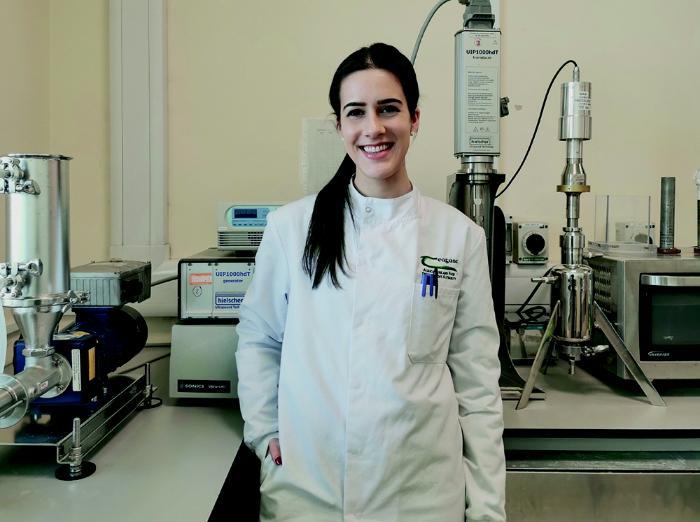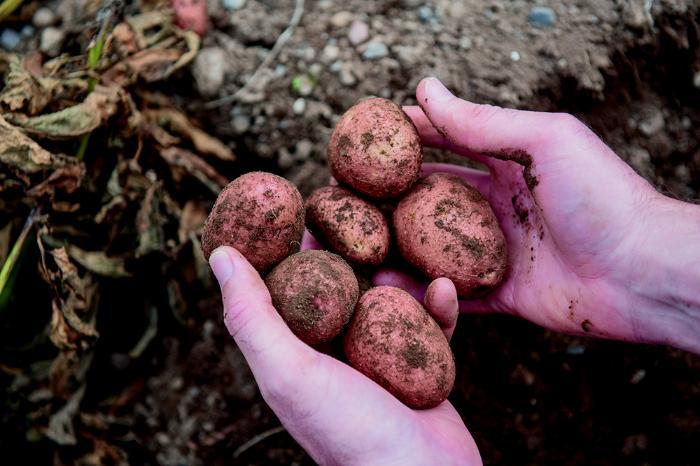12 June 2025
Chipping away at food waste
Potato processing side streams contain valuable nutrients like proteins and starch, which can be efficiently extracted using green technologies. Scaling up these processes enables a zero-waste biorefinery model, turning waste into economic and environmental benefits.
Both discarded whole potatoes and leftover scraps can be valuable sources of recovered proteins and starch. Credit: Andrew Downes
Each year, Ireland’s thriving potato industry generates thousands of tonnes of waste – from misshapen tubers to nutrient-rich wastewater. But new research from Teagasc is turning this challenge into an opportunity. Using innovative, eco-friendly extraction techniques, scientists are recovering high-value proteins and starch from potato processing side streams. These ingredients don’t just reduce waste: they offer functional benefits for the food industry, with potential health-promoting properties and economic value.
Reducing food waste is a major priority under the Sustainable Development Goals (SDGs) and the European Green Deal, which aim to cut food waste by 2030. The key to achieving this is shifting from a linear economy, where resources are used and discarded, to a circular economy, where waste is repurposed into valuable products.
From waste to high-value ingredients
Ireland has the highest per capita consumption of potatoes in Europe – around 80 to 90kg per person per year. With national production reaching approximately 300,000 tonnes annually, it’s no surprise that potato processing side streams are a major source of food waste.
These side streams include whole potatoes discarded due to shape, size or colour imperfections, as well as leftover scraps from cutting and peeling. Additionally, wastewater used for washing and starch extraction represents another major challenge, with three to five cubic metres of water used per tonne of potatoes. This wastewater is essentially a mix of water, starch, peels and pulp.
“The high chemical oxygen demand and biochemical oxygen demand of this wastewater make it a pollution risk if not managed correctly,” explains Giulia Romano, Postdoctoral Researcher at Teagasc Food Research Centre. “But what if we could turn this problem into an opportunity?”
Potatoes and their wastewater contain around 2% valuable proteins with exceptional nutritional and functional properties. Unlike many other plant-based proteins, these are allergen-free and highly soluble, making them highly attractive for food applications. Some even exhibit bioactive properties, such as anti-inflammatory and anti-tumour effects. Additionally, starch recovery is another promising avenue. With an average starch content of 18% in whole potatoes and 9% in wastewater, reclaiming this valuable resource can significantly reduce food waste while generating economic benefits for processing companies.
“By efficiently extracting both proteins and starch, we achieve a dual benefit,” Giulia states. “Less waste for the environment, more value for the industry.”

Lab-scale tests have achieved extraction yields of up to 60%; the next step may be to work at factory-scale, says Teagasc Researcher Giulia Romano. Credit: Andrew Downes
Clean extraction and scaling up
At Teagasc, researchers are developing eco-friendly extraction techniques to maximise nutrient recovery from potato side streams. These include traditional methods like grinding and sedimentation for starch recovery, as well as advanced green technologies such as ultrasound-assisted extraction and enzymatic hydrolysis, which break down cell walls to release proteins. Additionally, isoelectric precipitation is used to recover proteins from the solutions, producing high-purity protein isolates.
“The right combination of these techniques allows us to optimise extraction yields,” says Giulia. “For instance, enzymes can break down starch into sugars, which can then be used for fermentation to produce bioactive compounds, enzymes or even organic fertilisers.”
A critical step in making these innovations viable for industry is scaling up from laboratory experiments to real-world applications. Initial tests involved extracting proteins and starch from just one litre of side streams using ultrasound probes. The results were impressive, with protein and starch recovery rates reaching 90% and 80%, respectively.
The next challenge will be moving to industrial-scale trials. “We’ve tested these processes with volumes of up to 300 litres using industrial equipment,” Giulia explains. “Even at this scale, we’ve achieved extraction yields of up to 60%, proving that these methods can work in real factory settings.”
The future: a zero-waste model
Transitioning to large-scale implementation is crucial for making food waste valorisation a reality. Laboratory research lays the groundwork for optimising processes, while industrial trials confirm their practicality and economic potential. But the goal is a zero-waste biorefinery approach.
“In the future, every part of these side streams should be repurposed, not just to benefit the companies themselves but also to protect our planet,” Giulia emphasises. “This is the next big step for the food industry.”
By rethinking food waste as a resource, Ireland’s potato industry, and the food sector as a whole, can lead the way towards a more sustainable, circular economy.
Funding
Department of Agriculture, Food, and the Marine and Up4Food Project (EU funded)
Contributors
Giulia Romano, Postdoctoral Researcher, Teagasc Food Research Centre, Ashtown.
Shay Hannon, National Prepared Consumer, Food Centre Manager, Teagasc Food Research Centre, Ashtown.
Brijesh K. Tiwari, Principal Research Officer, Teagasc Food Research Centre, Ashtown. brijesh.tiwari@teagasc.ie

